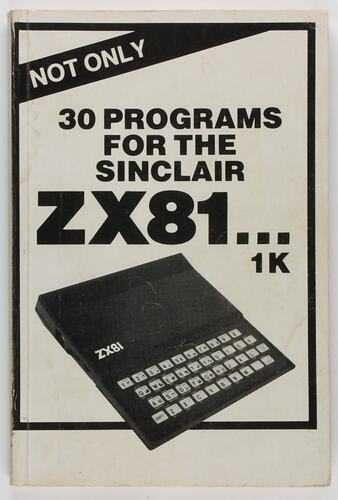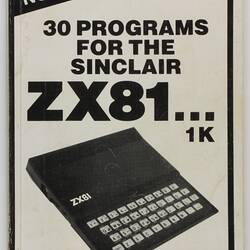Summary
Manual with listings of thirty programs that can be run on the ZX81 home computer. It is addressed to the person who also wants to learn how to program. It has a friendly inviting style. It was published by Melbourne House of South Melbourne. There is a publisher's note signed by Alfred Milgrom. Alfred Milgrom has played a significant role in software development over the years.
Description of Content
Manual with listings of thirty programs that can be run on the ZX81 home computer.
Physical Description
Bound booklet with off-white front cover. ZX81 computer illustration on front cover below printed text.
Significance
The Sinclair ZX81 home computer, released by the UK firm Sinclair Research in 1981, was part of the push to develop a mass market for cheap computers. This push led to a boom in companies producing hardware and softaware, which still continues in 2008. It had a very small component count.
'It was a real computer, you could do calculations, it was programmable, you could do lots of things with it - it was in every way a real computer at a very low price.' Interview with A. Tony Tebby of Sinclair Research, 24 October 1985.
'The secret ... of the lower price and improved performance of the ZX81 over the ZX80 is a new bipolar chip designed by Sinclair . . . The single integrated circuit concentrates 18 of the 21 chips of the ZX80, so that the ZX81 comes with only four chips . . . The new chip . . . eliminates the need for the processor to drive the TV display, thus causing the screen to go blank whenever processing was being done. The ZX81 processes in two modes: normal, where the display is constantly on, and fast, where processing takes place at four times the speed but data is only displayed either at the completion of a program, when input data is awaited, or during a pause.' (Infomatics, 16 March 1981.)
More Information
-
Collecting Areas
-
Acquisition Information
Donation from Helen Olsen, Henry Olsen, 19 Feb 2008
-
Manufacturer
Sinclair Research Ltd, Cambridge, Cambridgeshire, England, Great Britain, 1981
-
Past Owner
Alfred Milgrom, Melbourne, Greater Melbourne, Victoria, Australia, 1980
-
Inscriptions
Printed, cover, black ink: "NOT ONLY / 30 PROGRAMS FOR THE SINCLAIR / ZX81 . . . 1K"
-
Model Name or Number
-
Brand Names
-
Classification
Computing & calculating, Digital computing, Reference materials
-
Category
-
Discipline
-
Type of item
-
Overall Dimensions
139 mm (Width), 9 mm (Depth), 209 mm (Height)
-
References
[Link 1] accessed 15 July 2008
-
Keywords



